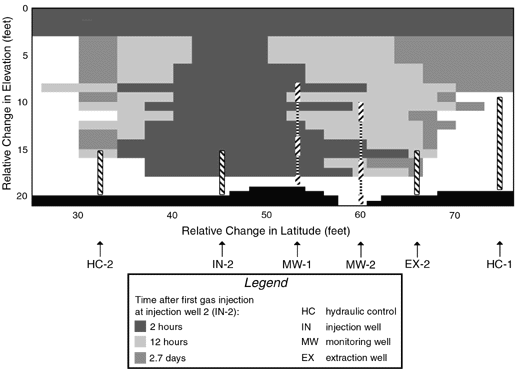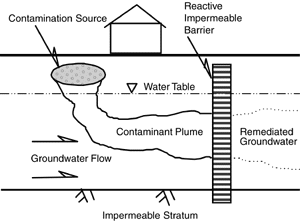Ground Water Currents, December 1998, Issue No. 30ContentsMicrobial Precipitation of Dissolved Metals Using Molasses Field Demonstration of a Surfactant/Foam Process for Aquifer Remediation Waste Paper Mill Sludges as Reactive Semi-Permeable Barrier Slurry Walls Resources Developed by the National Research Council Microbial Precipitation of Dissolved Metals Using Molassesby Eugene Dennis, U.S. EPA Region 3, and Suthan Suthersan, ARCADIS Geraghty & Miller, Inc. Preliminary results of operations at the Avco Lycoming Superfund site in Williamsport, PA, indicate that a new technique for in situ remediation is enhancing and inducing microbial reduction of dissolved metals in ground water. The technology involves the use of a carbohydrate solution (dilute blackstrap molasses and water) that is injected into the aquifer to reduce dissolved metals, such as hexavalent chromium, to less soluble states, such as trivalent chromium. This reduction process yields significant remedial benefits because trivalent chromium is less toxic, less mobile, and precipitates more readily than hexavalent chromium. The Avco Lycoming site is a 28-acre active manufacturing facility where hexavalent chromium contamination is located in a shallow, glacially-derived, silty sand aquifer. A 1991 record of decision (ROD) for the site called for a pump and treat system to be used, but the ROD was amended in 1996 to allow for in situ precipitation of ground water contaminated with hexavalent chromium. Clean-up goals specified in the ROD include a level of 0.032 mg/L for hexavalent chromium. The target area for in situ treatment is a shallow overburden approximately 25 feet below land surface covering approximately two acres. Collection of samples from monitoring wells indicated initial ground water concentrations of hexavalent chromium and cadmium as high as 3.0 mg/L and 0.8 mg/L, respectively. The technology used at this site is based on the rapid degradation of carbohydrates (primarily sucrose) present in molasses by indigenous heterotrophic microorganisms residing in the aquifer. This metabolic degradation process utilizes available dissolved oxygen to create anaerobic conditions conducive to reduction processes. As a result, hexavalent chromium is reduced to trivalent chromium, which then reacts with naturally occurring hydroxides available in the aquifer to form chromium hydroxide. Under alkaline to moderately acidic conditions, chromium hydroxide readily precipitates out of solution because of its extremely low solubility, and is immobilized in the soil matrix of the aquifer. Conversion of trivalent chromium back to hexavalent chromium is expected to occur only under extremely acidic conditions (pH less than 3.5). A small-scale field design test was conducted at the Avco Lycoming site over a six-month period prior to full-scale use of this technology. Within approximately 70 days of initiating molasses injections, analytical results indicated a decrease in hexavalent chromium from 2.4 mg/L to less than 0.01 mg/L in a monitoring well located approximately 5 feet from the injection wells. Analytical results of samples taken from a second monitoring well located 12 feet from the injection wells indicated a decrease in hexavalent chromium from approximately 3 mg/L to less than 0.01 mg/L within 155 days. Overall, hexavalent chromium concentrations in ground water decreased to below detection levels during the field test, and the concentration of total chromium also decreased. Full-scale use of this technology was initiated in January 1997, at which time daily injection of the molasses solution began. Analysis of quarterly ground water samples collected over an 18-month period indicates that microbial reduction has occurred in an area encompassing approximately 12,000 ft2. Substantial reductions in metal concentrations in ground water have been observed, including a 90% reduction in hexavalent chromium. In situ remediation of hexavalent chromium using molasses is continuing at the Avco Lycoming site. For more information, contact Eugene Dennis (U.S. EPA, Region 3) at 215-814-3202 or E-mail dennis.eugene@epa.gov, or Suthan Suthersan (ARCADIS Geraghty & Miller, Inc.) at 215-752-6840 or E-mail ssuthersan@gmgw.com. Field Demonstration of a Surfactant/Foam Process for Aquifer Remediationby George Hirasaki, Ph.D., Rice University The first field demonstration of a surfactant/foam process for removal of dense non-aqueous phase liquid (DNAPL) from a heterogeneous alluvial aquifer was conducted during the Spring of 1997 at Hill Air Force Base, UT. Air was injected to form an in situ “foam” in the zones of highest permeability that is capable of diverting surfactant solution to zones of lower permeability, thus improving removal process efficiency. This demonstration, which differed from others utilizing continuous surfactant injection without foam generation, proved the process effective in reducing the average DNAPL saturation of the swept pore volume to 0.03%. The surfactant solution was designed to mobilize and solubilize contaminants located in the lowest part of the saturated zone of the aquifer contained in a buried paleo-channel eroded into thick clay deposits. The demonstration was conducted in a 6.1-meter line drive well pattern with three injection and three extraction wells spanning the width of the buried channel (approximately 3.7 meters). Hydraulic conductivity ranged from 10-4 m/sec to more than 10-3 m/sec. The contaminated zones near the bottom of the channel (approximately 13.7 meters below ground surface) had hydraulic conductivities in the lower portion of this range. Contaminants consisted of 70% trichloroethene (TCE) and smaller amounts of other solvents and dissolved greases. Initial borings and a partitioning interwell tracer test (PITT) indicated that approximately 79 liters of contaminant was present initially. [See the September issue of Ground Water Currents for more information on PITT application.] The demonstration area did not contain a DNAPL pool, but instead a migration path of the contaminants to known nearby pools.
A solution containing 3.5% (by weight) of the anionic surfactant sodium dihexylsulfosuccinate was injected over a period of 3.2 days, for a total amount of 3.2 times the swept pore volume of the aquifer. During most of this time, air was injected for two-hour intervals at the three injection wells on a rotating basis. Monitoring wells showed that the foam first swept the upper intervals and thus diverted surfactant to the lower intervals where DNAPL was present (Figure 1). Moreover, injection of the nonpartitioning tracer with the surfactant indicated that foam reduced the swept volume by approximately 50%. Subsequent water flooding broke the foam and restored the swept volume to its initial value, as shown by the final PITT. Analysis of effluent showed that 140 liters of DNAPL was produced as a result of surfactant flooding. Since this DNAPL recovery exceeds the 80-liter estimate of initial volume present, additional DNAPL likely entered the pattern from the region beyond the injection wells. The amount of DNAPL remaining at the end of the test was very low based on the final PITT (10 liters) and post-test borings (6 liters). The average final DNAPL saturation in the swept volume based on the higher of these estimates was only 0.03% (77 mg/kg soil). These results show that the surfactant/foam process was successful in reducing the DNAPL source from the low-permeability zone at the base of the demonstration area. This project was sponsored by the Advanced Applied Technology Demonstration Facility (AATDF) of the U.S. Department of Defense located at Rice University. Researchers currently are conducting seismic studies to identify other structural low features in the base of the aquifer where DNAPL may have accumulated. Contact Dr. George Hirasaki (Rice University) at 713-285-5416 or E-mail gjh@rice.edu for a detailed report on this demonstration or more information. Waste Paper Mill Sludges as Reactive Semi-Permeable Barrier Slurry Wallsby Horace Moo-Young, Jr., Ph.D., Lehigh University Lehigh University researchers are assessing the feasibility of utilizing paper mill sludges for active semi-permeable barrier applications in situ. Paper mill slurry walls not only serve to contain contaminants such as heavy metals, but also attenuate the contaminants as ground water passes through the barrier system. As a waste product of the paper industry, mill sludge is available to users at little or no cost, while clay materials commonly used in slurry walls, such as raw sodium bentonite, can cost $70-100 per ton. In contrast to alternative slurry systems, the costs for paper mill sludge systems may be further reduced by the lack of need for expensive pump and treat systems to remove contaminants from the subsurface slurry. Figure 2 illustrates a conceptual model for a reactive semi-permeable barrier, where contaminants transported by the natural hydraulic gradient are immobilized by the sludge. Paper sludge has a low hydraulic conductivity (1 x 10-7 cm/sec or less), which makes the material ideal as a hydraulic barrier. Other properties that make paper sludge an excellent candidate for use as a slurry material are a high initial water content (2-5 times higher than the solids, by weight) and a low initial solids content (15-20%) prior to dewatering. After dewatering, the solid content is increased to 25-35%. In comparison, most slurry walls constructed with bentonite have a solid content of 5-15% before the addition of backfill soil.
Sequential batch equilibrium tests of heavy metal aqueous solutions at varying concentrations of lead and cadmium were conducted on paper sludge from a local paper mill. Resulting adsorption isotherms yielded information on the adsorption magnitude of contaminants, how much contaminant is sorbed, and the adsorptive capacity changes relative to contaminant concentrations. This information was used to compare the effectiveness of paper sludge with other adsorbents commonly used for lead and cadmium contaminants, such as sand-bentonite slurry. Conservative findings indicated that paper sludge has a comparable or higher sorption capacity than that of sand-bentonite mixtures. Paper sludge obtained directly from a mill wastewater treatment plant typically is composed of 50-75% organics (cellulose fibers and tissues) and 30-50% kaolinite clay. The increased adsorption capacity of paper sludge in comparison to kaolinite can be attributed to the higher organics content, possibly because the organic fibers and tissues act as electron acceptors in oxidation and reduction reactions. In addition, the higher organics content provides a carbon source for supporting microbial growth needed to enhance natural attenuation. To estimate the life-time expectancy of a reactive semi-permeable barrier constructed of paper sludge, site-specific testing prior to application is required. As organics in the barrier anaerobically decay, the barrier will become more like clay, thus acting like an impermeable clay barrier that will decompose more slowly over time. Furthermore, the rate of microbial activity typically is low because paper sludge is treated (disinfected) with chlorine or ozone. In earlier application as a landfill cover material, a 15% decomposition rate in organics contained in the paper sludge was identified after the first two years of use. Follow-on studies are underway at Lehigh University to evaluate mineral enhancement of paper mill sludge using fly ash and steel slag. For further information, contact Dr. Horace Moo-Young, Jr. (Lehigh University) at 610-758-6851 or E-mail hkm3@lehigh.edu. Resources Developed by the National Research CouncilNew information about protecting and remediating ground water is available from the National Research Council. Publications released during 1997 include:
Earlier publications addressing ground water contamination issues include:
To read these books on-line, access the National Academy Press (NAP) Web site at www.nap.edu/. For copies, contact the NAP at 800-624-6242 or 202-334-3313.
|










